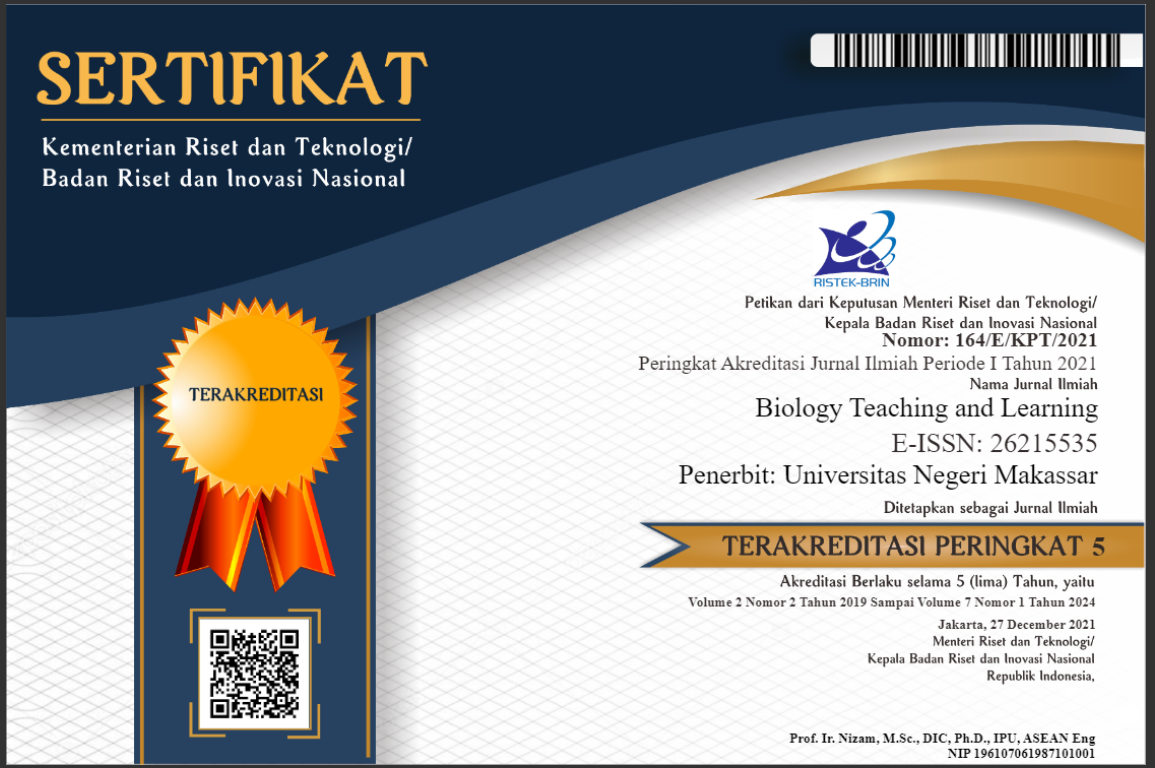Author Guidelines
Writing Article Guidance for Bionature
Editor policies
Biology Teaching and Learning is published twice a year, every Juni and December, containing papers/articles about the ideas and the research written by experts, educator, scientist, practitioners, and reviewers in the biological sciences discipline/study.
General requirements:
- The length of the article is between 3000 to 4000 words (including bibliography, notes, and tables).
- Attach a statement that the article has not been published yet in any other publication and in any forms.
- Each article will be given the test of plagiarism.
- The article consists of 9 components:
TITLE: USE CAPITAL LETTER, BLACK, LEFT INDENT, BOLD
The sections in the article do not use chapters (except for the research result and the discussion), but the indicators that the components or sections in the article stated can be seen at the first sentence in the first paragraph.
- The article is delivered using the following components:
Title: Maximum 12 words for article in Bahasa Indonesia. The font used is Times New Roman, 12, and bold.
The writer’s name: The writer’s name is written under the title using font Times New Roman, 10, bold, without titles, and cannot be shortened. Under the name of the writer, it is written the areas of expertise, institution name, and the email address of the writer.
Abstract: no more than 200 words, written in both English and Bahasa Indonesia in one paragraph
containing: The research objectives, research methodology, data analysis, and research findings. It is typed using font Times New Roman, single space.
Keyword: Maximum 5 words, separated with comma, typed using double space under the abstract. [font Times New Roman, 11, single space, italic]
Introduction: The introduction is written using capital letters [font Times New Roman, 12, bold] containing the background with a problem solving, the urgency and rationalization of activities, bibliography, solution plan, the objective of the activity, and hypothesis development. [font Times New Roman, 11, Normal]
Methodology: Research methodology explains about: the approach, scope or object, operational definition in each variable/description of research focus, place, population and sample/informant, main source and tool, the technique of data collection, and technique of data analysis. [font Times New Roman, 11, Normal]
Methodology: Research methodology explains about: the approach, scope or object, operational definition in each variable/description of research focus, place, population and sample/informant, main source and tool, the technique of data collection, and technique of data analysis. [font Times New Roman, 11, Normal]
Findings and Discussion: The findings are presented in full and related to the scope of the research determined before. The findings can be completed with tables, graphs, and/or charts. The tables and pictures are given number and title. The result of data analysis is explained correctly in the article. The discussion part logically explains the findings, associated with the relevant sources. [Times New Roman, 11, Normal]
Conclusion and Suggestion: The conclusion contains a short summary of the findings and discussion. The conclusion is the findings in the research that has the answers for the research questions or the objective of the research. The research findings give suggestions or contributions to the application and/or the study development. [Times New Roman, 11, Normal]
References: containing referenced sources with a minimum of 80% of books last 10 years issue. The references are written based on the American Psychology Association (APA) Fifth Edition. using reference manager Mendeley,










